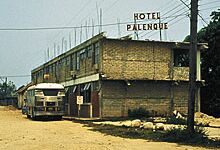
Part 2
Art in deserted buildings and deserted spaces
| 1969 - During a trip to Mexico Robert Smithson photographed an old, eccentrically constructed hotel, which was undergoing a cycle of simultaneous decay and renovation. Smithson used these images in a lecture presented to architecture students at the University of Utah in 1972, in which he humorously analysed the centerless, “de-architecturalized” site. Extant today as a slide installation with a tape recording of the artist’s voice, Hotel Palenque provides a direct view into Smithson’s theoretical approach to the effects of entropy on the cultural landscape. |  |
1970 - Terry Fox chose to reveal the basement of a newly opened gallery, ignoring it's new white exhibition space - complete with a bum named Ronnie who had been sleeping in the artist's doorway for three days.
| 1970 > Charles Simonds built miniature dwellings of the "little people" on abandoned buildings and in vacant lots on the Lower East Side of New York. He was all the time elaborating the fantasy of their migrations, appropriate to that decaying quarter of New York that has been home to successive waves of immigrants. He worked by spreading clay on a ledge or in a niche, then building with tiny clay bricks the shelters and ritual places of his little people. | 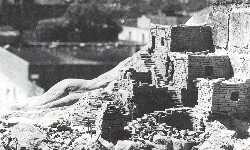 |
| 1971 - Vito Acconci performed Security Zone at Pier 18 in New York with Lee Jaffe: |
|
| 1971 - During an entire month in 1971 Vito Acconci waited each night at the far end of a pier from 1.00 to 2:00 A.M., having promised to reveal to anyone who cared to meet him there something that he would normally keep concealed (Untitled Project for Pier 17). | 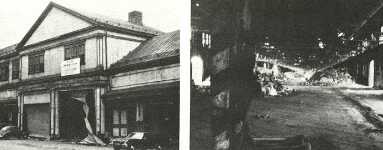 |
| 1975 - Gordon Matta Clark cut large holes into the walls of Pier 52 on the Hudson River. The work "day's end" resulted in a warrant issued for the artist's arrest and his eventual flight to Europe. In 1975 he made a cut in two houses in Paris. The cut was shaped like a twisted cone. A very dangerous, but powerful artwork. (Conical Intersect 1975). He also made films in 1977 about underground structures in New York (New York Central Tracks, Grand Central Station, 13th Street, Croton Aqueduct in Highgate, ...) and Paris (architectural ruins, car parks, tunnels, ossuaries, cellars, crypts and basements in the Opera district). | 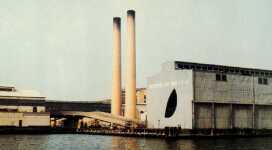 |
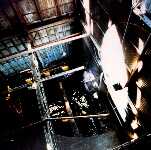 |
| 1979 - Internal Sound was performed by Terry Foxin in the former Church of Santa Lucia (Bologna, Italy) empty and unused since World War II. The church is filled with dark corridors, spiralling stairwells, puddles of stagnant water, and the constant murmuring of pigeons whose droppings cover the floors. The performance could only be seen through a hole in a door. | I found a wooden covering over a hole in the floor that led to the crypt, which was very resonant, directly in line with the hole in the door. I stretched two parallel piano wires between the door and the crypt cover at chest height. The heavily rosined wires were played by stroking and pulling them gently, producing a sound loud enough to be heard in the street. The words Suono Inteno (Internal Sound) were chalked on the outside of the door along with an arrow pointing to the hole so that passers-by could peer in and discover the source of the sound. I played the wires six hours a day for three consecutive days. | 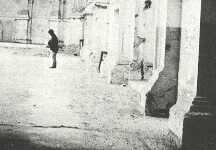 |
1990 - Anya Galaccio placed 21 polished metal tea-kettles on a rustic wooden table in the chimney of the Old Pumping Station, Wapping, London. A constant supply of water and electricity produced a cacaphony of whistles. (In spite of it all)
1990 - Gu de Xin made an untitled work in a disused pumping station in Wapping (London). Clear plastic curtains, in which holes had been burned, cascaded down from the ceiling on to rusting industrial equipment. The installation looked like combination of a waterfall, Christmas lighting and primordial slime.
1990 - Christian Boltanski installed an artwork in the gap between two houses in the Grosse Hamburger Strasse. The gap was caused by the demolition of a house in W.W.II when it was struck by a bomb. Boltanski installed a series of plaques containing the names and occupations of the former inhabitants of the missing house and the period that they lived inside the house. The inhabitants were not killed by the bomb that destroyed the building, but were deported to German concentration camps.
1990 - Per Barclay, a Norwegian artist, fills the floors of interesting spaces with a thin layer of black motor oil. The floor becomes strangely reflective, but it is impossible to guess the depth of the dark layer. (The jaguar's cage, Turin Zoo, Italy - Old Boathouse, Oksefjord, Norway).
1990 - Tadashi Kawamata is known for installations that transform "normal" buildings into derelict-looking buildings. In his construction on the Annely Juda Gallery in London planks protruded in and out of windows and a very unstable scaffolding seemed to cover the front of the building. The whole structure suggested that the building had become structurally unsound.
1990 - David Tremlett made beautiful pastel drawings in abandoned houses in Tanzania. Later he heard that his abstract drawings had been destroyed by local youths the day he left. Only the photographs remain. (Mjimwema Drawings Abandoned Houses) |
 |
 |
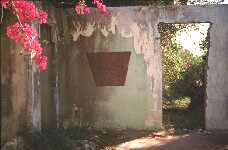 |
| 1993 - Ilya Kabakov created School No.6 in a derelict Texas military compound. The work represents an abandoned schoolhouse from the former Soviet Union. There are rooms filled with faded posters, flags, medals, Red Army toys and emblems. Everything is broken, boarded-up, and neglected. Bookcases and desks with Russian notebooks, and memorabilia scattered throughout the disordered classrooms tell of another place and time. The walls are painted an institutional green, which is peeling. In the center of the building is a courtyard overgrown with grass. In faded red and glass enclosed vitrines, Kabakov recounts the stories and poetic recollections of the students’ past experience in the school. | Part of the story as designed by Kabakov: "The school was closed. No one had any need for the school building or for the other buildings of of the village, and today there is emptiness and oblivion, where just yesterday there was life and voices resounded. The rooms are empty, the courtyard is overgrown with grass up to one's waist, and there is only wind, freely blowing through the building through the emty windows, rustling the children's notebooks left on the floor and the announcements about lessons and old maps on the peeling walls." |
1994 - Zhan Wang's action "Ruin Cleaning Project '94" manifests an ironical and critical intervention in the general destruction/construction in China. One day in October 1994, he came to a demolished neighbourhood in Central Beijing. He cleaned walls, windows and doors of a destroyed house and redecorated them carefully with paint in order to "renovate" the ruin. The action was interrupted when the house was razed to the ground.
1995 - Chinese artists Shan Fan, Xu Jianguo and Zhan Wang realised an intervention in the ruined Academy of Fine Arts in the centre of Beijing which was demolished after the land was sold to a Hong Kong developer who intended to build a huge shopping mall at the place. To say farewell to the most important art school in China, the artists collected the debris and built a temporary "sculpture park". Artist Yu Fan's built a minuscule swimming pool in the middle of the ruin. He named it, with a great sense of humour, "Beautiful Landscape".
1995 - Dominique Kippelen uses a deserted warehouse in the Rhine harbour in the city of Strassbourg. She builds 1200 square meters of gardens in the three-storied buildings. The dark cellars are used for inorganic desert-gardens made of heaps of sand and earth. The dim lower floors are used for moss gardens growing over broken bricks and cinder blocks. In the upper floors she plants wheat. The wheat grows white in the dark areas and green in the lighter areas. As long as her work doesn't draw too many visitors she is tolerated by the port authorities.
| 1996 - Willie Doherty makes work which refers to the situation in Northern Ireland, where many people's lives have been touched by violence. - In the video installation 'The Wrong Place' we follow the camera as it moves down a darkened staircase and travels through an abandoned building, illuminated only by the video camera’s light, as if searching for something. The effect is enhanced by the sound of footsteps. At the end of the sequence the footsteps break into a run, the screen plunges into darkness and a moment later, the search begins again. http://www.dareonline.org/themes/space/doherty.html | 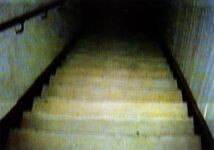 |
1999 > The artist Tim Kaulen works in an abandoned steel mill. He constructs large farm animals out of metal and hangs them surreptitiously from bridges and abandoned buildings. One of his recent works is a two-story high deer head built out of found scraps. It stands on the roof of one of the buildings. (There are pictures on his website, but they can't be reduced to the standard size of this list, see the links below.)
| 2001 - Juan Cruz created the loop "Disused Track". In the video, he follows the route of a railway line between Cambridge and Huntindgon that has fallen into disuse. Most of the rails are overgrown and many stretches of the former railroad are impenetrable, but where a roadway or footpath crosses the rails some places are still accessible. Cruz recorded video footage for a whole day at twelve of these crossing-points, spread along the whole length of the route. This means that the light slowly intensifies and dims as he follows the route. The various open spots along the track bring to mind decors that provide space for stories that have yet to be told. | 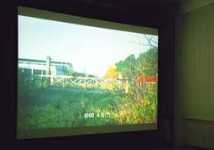 |
| 2002 - Inge Broska stayed behind in the doomed town of Otzenrath (Germany) and she kept a diary of the changes as more and more people left. The town will be torn down for a strip-mining operation. - Ever more people leave the old village. Soon there will be nothing to buy anymore. The last butcher - and we had 4 - has closed at the end of this year. - The once carefully maintained gardens now attract wild animals and plants. Birches grow in bathrooms, mice and rats play in kitchens and dwellings. And the abandoned cats multiply wildly. The fast-growing ivy provides "romance". More and more windows remain dark in the evening. - http://www.derstillstand.de/10/broska/ - http://www.ultimate-akademie.com/broska/last_exhibition_heimatmuseum.htm | 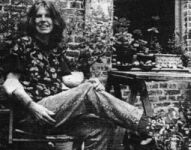 |
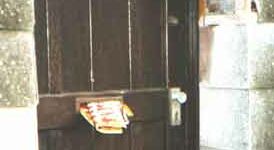 |
Explosives & pyrotechnics & guns
1951 > William S. Burroughs accidentally shot his wife through the forehead in the early morning of 6 September 1951 while performing a "Wilhelm Tell" stunt. The original objective was to shoot a glass standing on her head. Soon afterwards he moved (fled?) to Tangier where he led the life of a junkie, shooting a needle every hour and living amidst garbage piled up to the ceiling. In his later years he made several artworks by firing his gun at painted plywood boards and by blasting cans of spray-paint with a shotgun. (Lucifer rising, 1988)
| 1965 - Niki de Saint-Phalle made a white environment that was not completed until the guests at the exhibition fired paint-bullets at it. (Autel Tir) But another version of this story says that the white plaster artworks contained balloons with paint that was released by shooting holes in the artwork. |  |
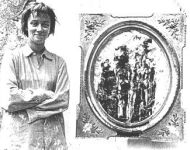 |
| 1970 - Jean Tinguely showed a self-destructing gold-coloured sculpture in front of the cathedral of Milan. The work was built in secret, covered under a purple cloth carrying the initials of the Nouveau Réalisme movement. Immediately upon it’s unveiling, in front of a few thousand people, the large penis started exploding. Soon afterward it collapsed in flames and ashes. (La Vittoria) | 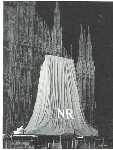 |
 |
|
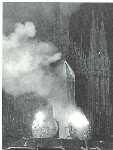 |
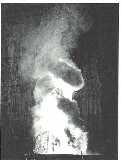 |
| 1972 - Chris Burden placed two XXs constructed of 16 foot beams in an upright position blocking both lanes of the road. The wood had been soaked in gasoline for several days. The artist set the XXs on fire and left the area. | Dos Equis was made for just one person. I do not know who he is or anything. He was just the first one to come upon those big XXs burning in the road. For whoever saw it, it must have been an unforgettable experience. | 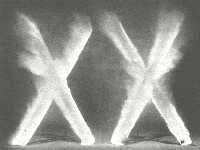 |
1973 - Wearing no clothes, Chris Burden entered his studio from a small room at the back. Two assistants placed one end of 60-foot sheets of glass on each of his shoulders. The sheets sloped onto the floor at right angles from his body. The assistants poured gasoline down the sheets of glass. Stepping back they threw matches to ignite the gasoline. After a few seconds the artist jumped up, sending the burning glass crashing to the floor. (Icarus) - According to some sources just a few invited friends were present as audience and witness as Chris Burden narrowly escaped being set on fire.
1973 - Chris Burden fired a gun at a jet plane. (747)
1977 – Dennis Oppenheim -
Explosions detonated five to six feet below the ground
produce craters that measure from four to ten feet in
diameter. The explosions leave impressions resembling
knuckle marks on the earth. - Lolo near Missoula, Montana
– Black Powder - (Three Downward Blows –
Knuckle Marks)
|
 |
1981 – Dennis Oppenheim ignited another fireworks structure indoors, in a gallery in New York's Soho district, on an evening when only critics had been invited to preview it. The huge complex firework created havoc and cleared the gallery. Mobile towers with tanks of butane gas were used to ignite the different areas', wheels turned, chain reactions occurred, fires swept down swooping ramps as from the sky, and the piece exploded like a house of cards. Some viewers hit the floor, others headed for the door. The fire department came and broke the windows to clear the smoke. Everyone’s clothing had burn marks from flying sparks. (Launching Structure #2)
1982 – Dennis Oppenheim erected a firework sculpture on the beach. It looked like an amusement park in miniature, it featured rockets, fountains, and flares mounted on an armature of ladders, suspended bridges, and transparent spinning cylinders. Around it on the sand stood a number of shields with little windows, mounted on upright frames, behind which spectators could stand and be safe from its fiery expressiveness. (Formula Compound, A Combustion Chamber, An Exorcism - From the Fireworks Series)
| 1987 > Using heat-resistant gear David Hall is able to create living fireworks as an art form. He uses costumes, props and sculptures. He used to make up his own characters, but is now often using existing characters from religion, folk culture and mythology. | "In researching my projects I have discovered that "living pyrotechnics" was an art form that flourished in the 16th and 17th century in Europe. The "Green Man" was a costumed figure covered with green leaves that acted as protection from the pyrotechnical devices strapped to his body and from devices he carried. This figure acted as advance publicity wandering the streets emptying houses and pubs and leading throngs of people to the larger fireworks displays in public parks or royal residences." | "Most traditional fireworks displays occur several hundred feet in the air with no relation to the human body. My performances are much more intimate and ground based. Because of the kind of fireworks that I use I can safely bring the audience closer to where they can relate the fireworks to the body smell the smoke and feel a closer relationship to the medium than with traditional fireworks displays." |
| 1987 > Seemen from San Francisco, is is the effort
of Kal Spelletich, inventor of extreme technology. Seemen
create situations where audiences are encouraged to
interact with and operate potentially dangerous machines
like: - JAWS OF LIFE - a falling bed you get strapped
to with a giant pair of claws slamming closed around you "I guide audience members from machine to machine, telling a story about each one, why I built it, how I built it, what it does for me and what I want it to do for them. They are allowed to explore and interact with each one." http://www.seemen.org/ |
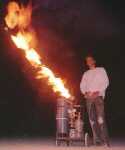 |
| 1990 > For several years
Naoya Hatakeyama has been photographing limestone
quarries and processing plants. His pictures often show
massive factory buildings, mazes of large pipes and
conveyor belts, smokestacks, piles of limestone, cement,
or aggregate, quarry landscapes, hills that have been cut
away and geological formations. Recently the artist also made photographs of explosions in limestone quarries. Taken with a remote-controlled camera, metres from the explosion, the high-speed images arrest the explosive movement, yielding pictures that look like clusters of asteroids hurtling through space, or volcanic eruptions. |
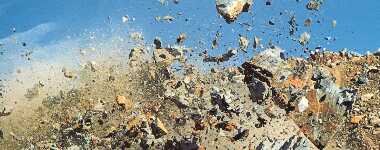
|
| It is almost unbelievable that
the film still can be recovered after surviving all this
violence. (Lime Works: Blasting,1995-98) http://www.photonet.org.uk/programme/past/hatakeyama2.html |
| Roman Signer
(Switzerland) - 1938 born in Appenzell - lives and works
in St. Gallen - The artist uses explosives, air pumps,
catapults and the physical forces of nature to make work
that is thrilling and dynamic in every way. He combines
elegance with anarchy and a lightness of touch with dark
humour. Buckets, rubber boots, tables and cardboard boxes
are used in "experimental setups" using
balloons, fire extinguishers, tin cans and blow torches. (All pictures are published with permission of the artist) |
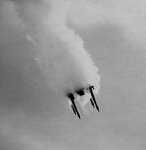 |
|
| 1999 - The artist made a simple wooden crate. At the back of the crate the artist has placed a table and chair, in the front a wooden beam, spanned between floor and ceiling, on which three cans -filled with black paint are fixed at a tilt. They have been fitted with blasting caps and connected to each other. The artist, in protective clothing and a helmet, is seated at the table with his hands on the tabletop. An explosive charge ignites the caps simultan-eously: with a violent bang paint shoots out of the cans like volcanic magma, sprays the interior of the cabin, while the human body and table on the back wall and the hands on the table are reproduced as negatives (Cabin). |  |
 |
| 1997 - Here you see the artist installing explosives
and paint in a steel drum and then exposing himself to
the blast. He is very security-conscious, notice the
helmet. He also has received formal training as a
pyrotechnician.us (Performance at the Melkfabriek,
Performance at Forde, Geneva) In the years when he started out on his artistic career Roman received a phone call from an unknown person called Signer. His comment was: "With all the silly things that you are doing one is almost ashamed of having the name Signer". In 1999 he was the artist representing Switzerland at the Venice Biennale. |
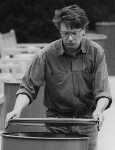 |
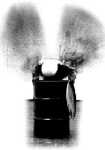 |
| 1991 - The artists places 10 inflatable baths in a row and puts a stick of dynamite in each. Then he walks outwards lighting the fuses. After lighting the fuses he walks back in the opposite direction towards the fountains caused by the explosions. "In fact I'm walking towards my past. I'm confronted with my past actions." (10 Becken, Installation at Ars Electronica) | 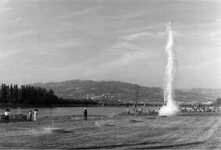 |
|
| He laid a fuse between two Swiss stations. The flame moves with the incredible speed of 150 seconds/meter. It took Roman and his team 35 days to bridge the distance of 20 km. The flame was started by lighting a heap of gunpowder at the starting point. At the endpoint again a heap of gunpowder was lit. The 100m sections were connected by boxes containing small heaps of powder. | 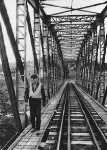 |
|
| Other examples of Roman Signer's performances: | ||
|
||
1991 - Cornelia Parker exhibited an ordinary garden
shed, and it's contents in the Chisenhale Gallery in
London. Then she moved the shed to a military site and
blew it up with explosives. The resulting fragments were
then randomly rearranged in the gallery and were hung
from thin wires from the roof. This hanging cloud of
debris retained the essence of the original shed and the
explosive nature of it's destruction. (Cold dark matter)
|
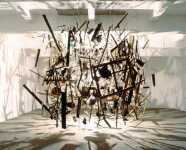 |
1992 - Christian Jankovski made the video The Hunt. It is set in a supermarket and it features the artist "hunting" his goods with bow and arrow and "spearing" such goods as coffee, toilet paper, vegetables and a frozen chicken before placing them on the conveyor belt to be purchased.
1996 - The
Illumination Project creates temporary monumental
artworks. The installations transform the environment
through impossibly large paintings that float just above
the earth. Then they vanish in a dance of wind and fire.
The Illumination Project has joined realization with
destruction to create a new union where planning,
creation, transition and remembrance become art.
|
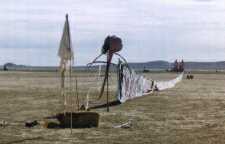 http://www.burningart.com http://www.burningart.com |
1996 - Peeter Pere (Estonia) made artworks by firing bullets at a board of plywood and then exposing the frayed backside (Parabellum).
| In 1997 she constructed Mass (Colder Darker Matter)
from the charred remains of a Texas church that was
struck by lightning. "I went down and asked the Baptist minister if I could have the charcoal to make a charcoal drawing - which is what I consider this to be. I like the way that all the emotion of religion and the drama of lighting can be distilled into a very simple, quiet piece where all I'm doing is presenting the charcoal..." http://www.artseensoho.com/Art/DEITCH/parker98/parker1.html |
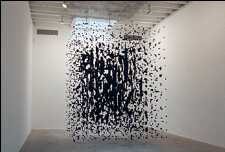 |
| 1998 - Eric Hobijn built the Dante Organ. It consists of 12 flame throwers synchronized by a computer. It can produce pillars of fire 13 to 20 meters high. The noise of the valves and switches is amplified and used as a rytmic background for the speactacle. - http://leden.tref.nl/~laar0118/hobijn.html - http://www.werkleitz.de/~pape/d/04projects/1995hobijn/hobijn.html - http://www.art-lab.com/medusa/dante.htm | 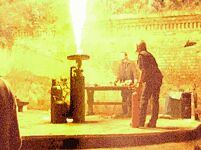 |
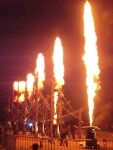 |
| 1998 - Seth Maxwell (Malice) and friends set out to Black Rock Desert, NV to make higly pyrotechnic artworks: | Our aim was to blow away fueled propane sculptures, lightly toasted with gasoline, attached to hacked out, machined objects d’art. Like letting the gas run for a couple of minutes before striking a match, it was all going to go up in smoke in a fucking large, soon to be, disposable, explosive piece. Very, very, explosive. This is Pop Culture from Hell. | 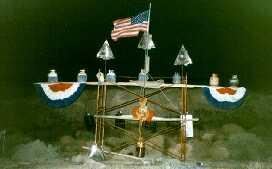 |
| Apparently, being the talk of the town, the authorities caught wind of our exploits. The Washoe County Sheriff pulled up. I could only imagine what they were saying to each other... They were sporting a highlighted Xerox of Nevada state legislature. It concerned the ignition of bombs on BLM (Bureau of Land Management) land. We had to tear it all down, and eventually move along. | Nothing left to shoot. We surveyed the damage...everyone was dumb-struck. It looked like someone called in an air-strike in front of us. The ground was littered with shredded tanks, and spent shells. The scaffolding was blazing away, with an occasional propane tank blowing up. It felt like we all survived a bad-ass fire fight. It felt like we did something no one else on the planet would of been crazy enough to do. | 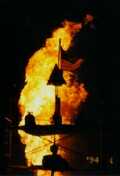 |
| 1977 - San Francisco Bay Area artists Mike Mandel and Larry Sultan collected a varied smorgasbord of images from more than fifty photographic archives maintained by scientific research facilities, police departments, cities, and universities. Left with no firm hook to hang a specific meaning upon, you can read the imagery as aesthetic or utilitarian, as critical or complicit. The images record unfathomable activities in mysterious locations and may be more interesting than photographs intentionally made to be "art." (Evidence, published as single prints and in book format) | 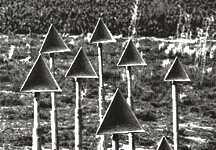 |
| 1978 - The Israeli sculptor Dani Karavan created his first laser display in Florence. An 8-watt argon laser beam connected the Belvedere Fortress with the cupola of the cathedral. This work was entitled Environment for Peace and is also referred to as an Homage to Galileo Galilei. In 1983 he connected the Musée d'Art Moderne with the Eiffel Tower and the new Défence quarter, using two green argon laser beams. The linkage symbolised the close relationship between historic and contemporary artistic, architectural and technological achievements. | 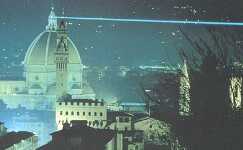 |
1970 - The Celestial Wheel (The Fusion of Art and Science) is the most ambitious projet of Jean-Marc Philippe. He wanted to encircle the Earth with a corona of orbiting satellites. The system uses a circle of about forty geostationary satellites in an equidistant orbit with laser beams that can be activated by remote control from the ground and can then emit light signals that from Earth would appear slightly brighter than Venus at its maximum luminosity.
1969 > Otto Piene works with many different technologies like kinetic sculptures, programmed light installations, laser light projections, computer processing, holography and telecommunications. One of his aims is to create environments and to enter as far as possible into the Earth's atmosphere and even beyond. His most "urban and adventurous" works are the gigantic floating sculptures (lighter than air) that he showed on many occasions.
| 1989 - Pierre Comte made Art-Spot 'Earth Signature'. The artwork consists of 16 black squares, large enough to be visible from space. On 6 October 1989, at 830 km from the earth, the satellite SPOT 1 photographed this symbol of "Planet Earth" - the first aesthetic event between outer space and the European continent. | 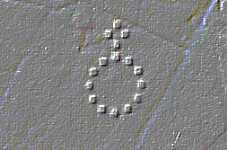 |
1994 - Palestinian-born Mona Hatoum (h. 1952) inserted a tiny camera inside her body and projected the video of her internal organs in a circular structure resembling an eyeball placed on the floor of a walk-in installation. Viewers are given the simulated experience of walking through the artist's reproductive system. (Corps etranger)
1998 - The artwork Border Patrol (by Paul Garrin) consists of 4 robot-operated video-cameras, computers and monitors. Visitors are automatically tracked by the cameras as the move around the space. They can see themselves on the monitors together with the status of the computerised tracking programme: scanning, tracking, lock, fire, verify. The monitors show how easily the spectators could be shot by a computer-controlled sniper. The spectators soon find out that they cannot escape detection and "execution", the programme is simply too powerful.
2000 - Using a power laser H.A. Schult drew a 1 km long yellow line in the skies over Frankfurt. (Der gelbe Kilometer)
2000 - A picture of the sky above the German Schwarzwald was flown through the skies of Florida. (German Sky Piece). In 1999 the artist (Michael Klant) arranged that a banner with a picture of Florida skies was flown over the Schwarzwald. (Florida Sky Piece)
1921 - On 14 April the Paris Dadaists organized an excursion to the little-known deserted church of St Julien le Pauvre. Guides were (among others) Breton, Eluard, Picabia and Tzara. Posters advertised the event throughout the city. They promised that the Dadaists would remedy "the incompetence of suspect guides and cicerones", offering instead a a series of visits to selected sites, "particularly those which really have no reason for existing". (* what else do we do during urban exploration?)
| 1961 - Dick Higgins made several "compositions". For example: A Winter Carol - Contribution #6 | Any number of people may perform this composition. They do so by agreeing in advance on a duration for the composition, then by going out to listen to the falling snow. |
1963 - Ken Dewey's "City Scale" took the spectators through the streets to a series of occurences and places: a model undressing at an appartement window, a car ballet in a car park, a singer in a shop window, weather balloons in a desolate park, a cafetaria, a bookshop, and as the sun came up on the next day, a brief finale by a "celery man" in a cinema.
| 1967 - Smithson's essay "A Tour of the Monuments of Passaic, New Jersey" was published in Artforum. - The artist gives an account of a walk in the ghost suburb of Passaic one Saturday afternoon. He describes and photographs the entropic industrial landscape with its building sites, factories and bridges. The deserted building sites are called "ruins in reverse". As opposed to the romantic ruin, the various buildings do not crumble into ruins after they have been realized, but are built as ruins before they are completed. | 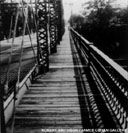 |
 |
| 1968 > Richard Long makes poetic works with natural materials. He is well known for his circles, rectangles and lines made from stone and driftwood that he arranges on the floors of galleries. Often he adds large, roughly drawn mud-circles on the wall. Another part of his work are long walks through nature that he documents in texts and photographs. During the walks he often makes site-specific works like stone circles, crosses and lines made by walking or by throwing water on rock. | FROM TREE TO TREE PALM A WALK IN AVON ENGLAND 1986 |
1968 > Between 1968 and 1979 On Kawara (Japan) recorded the exact routes he took through the city (of Europe, Africa, USA) every day. His route was traced in red ballpoint on a photocopy of the city map. Every stopping place was marked with a dot. No other comments are given. (I went)
1968 - Robert Smithson built his first Nonsite in a remote area of southern New Jersey. The "Nonsites" were constructed primarily from natural materials he chose from remote, unpopulated areas, or the ruins of collapsed buildings. - "I began in a very primitive way - certain sites would appeal to me - sites that had been in some way disrupted - pulverized. I was really looking for a denaturalisation rather than built up scenic beauty - when you take a trip you need precise data and I would often use maps - mapping followed travelling."
| 1969 - John BALDESSARI took a map of the US and located the places where the letters that spelled "California" were in the real landscape. Then he wrote the letters in that spot. The idea was to see the landscape as a map and to adually execute each letter and symbol of the map employed on the corresponding part of the earth. It was an attempt to make the real world match a map, to impose language on nature and vice versa. The letters vary in scale from 1 inch (2.5 cm) to approximately 100 inches (250 cm), and in materials used. The letters are located as nearly as possible within the area occupied by the letters on the map. |
|
1969 - While in Mexico, Robert Smithson created the Yucatan Mirror Displacements (1–9) by installing 12-inch-square mirrors on dispersed sites. The resulting series of nine color photographs was published in Artforum to accompany Smithson’s essay “Incidents of Mirror-Travel in the Yucatan” (1969). The mirrors reflected and refracted the surroundings, displacing the solidity of the landscape and shattering its forms.
| 1969 - Dennis Oppenheim - Shoes cut with one-quarter inch diagonal grooves down the sole and heel are worn for three months, leaving behind a pattern of shoe impressions that connect the previous patterns produced by thousands of individuals. - New Jersey and New York City - Duration 3 months. (Ground Mutations) |  |
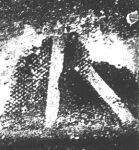 |
1970 - Nomura Hitoshi (Japan) focused on everyday events, describing random events without attaching any significance to them. For example, on July 6, 1970, Nomura made a series of verbal reports from public phone-booths ("Through the pale blue glass, I can see street trees") and presented the resulting transcripts in book form.
1971 - In "Earthwork- Timezone Map of the World., Timezone Chart" Philip Dadson (Australia) had fifteen people around the world record local circumstances at exactly 1800 hours Greenwich time, on September 23 and 24, 1971.
| 1972 Jan DIBBETS Artist's statement |
I really believe in having projects which in fact can't be carried out, or which are so simple that anyone could work them out. I once made four spots on the map of Holland, without knowing where they were. Then I found out how to get there and went to the place and took a snapshot. Quite stupid. Anybody can do that. - I discovered it's agreat feeling to pick out a point on the map and to search for the place for three days, and then to find there are only two trees standing there, and a dog pissing against the tree. But someone who tried to buy that from you would be really stupid, because the work of art is the feeling, and he couldn't buy that from me ... |
1974 - Susan Hiller invited seven people to sleep in a field that was noted for it's large concentration of mushroom rings - they recorded and mapped their dreams each morning.
| 1975 Alan SONFIST Autobiography (These are the statements I like most.) |
|
1976 - Joshua Neustein visited boundaries that demarcated points of high international tension (Golan Heights, Northern Ireland etc.) with a male dog. The dog urinated on the land at each site. Neustein photographed the dog during it's act and created posters explaining the action. The he made a map juxtaposing the territory marked by the dog with the territory claimed by the opposing nations ("Territorial Imperative").
1976 - Rodney Graham walked through rough overgrown terrain at night, without a light but with his camera. He was able to make his way through the wild nature by using his flash to cast a bright but short light on his surroundings. - In the long sequence of nearly identical shots the terrain looks wild, dark, and treacherous. Ironically, the intensity of the glare blinded the photographer, making him temporarily blind to what was in front of him during those very instants that the images were forming themselves on the paper. (75 Polaroids)
1976 - The russian group Collective Actions took performances to the fields on Sundays, necessitating a trip by metro and a trek through snow. Lev Rubinshteyn and Nikita Alekseev walked out of the forest, into a field, and gave their friends who had gathered there a certificate of attendance.
1977 - Jochen Gerz made a journey as his contribution to Documenta 6. Sitting in a compartment on the Trans-Siberian Railroad, he travelled the distance Moscow-Khabarovsk-Moscow. The windows remained covered during the journey, so that nothing outside could he seen from within the compartment. Thus he was to travel through Siberia, the Taiga and the Amur region to reach the tip of Eurasia and return in the same compartment to Moscow, where after travelling 16,000 kilometres he was to arrive again at the point of departure. He was to take sixteen writing slates on the journey, which was to last sixteen days and nights, one writing slate for each day. He was to place his feet on them. It was also agreed that there was nothing to be left over from the journey. Any proof of its occurrence was to he burned. So that someone learning of it later could not be sure of whether it had happened or not.
1977 > MARIO REIS creates paintings by anchoring a stretched, untreated cotton canvas in a river or stream for a period of up to three weeks. Mineral and organic material, including pollutants, carried by the river gradually accumulate on the surface. Reis came up with the idea in 1977, when he threw a painting into the Seine. Since then he has made these "natural watercolors" in more than 80 countries. The blank painting spend up to 3 weeks in the river. Then the natural marks are fixed with acryl lacquer. Mario Reis also creates "automatic" drawings. He sits in the middle of the landscape, blindfolded, and tries to keep his hands still above a piece of paper. Sometimes for more than two hours. He holds a pencil in each hand. The drawing is made by the involuntary movements of his hands. |
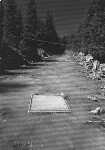 |
 |
1978 > Hermann Stamm photographs and documents unspectacular but grim places of death (Der verbotene Tod):
1983 - Holger Drees (Germany) studied and photographed the many different garden-gates and lanterns of the luxurious residential estates in his city. He was interested in the boundary demarcations between the public and the private domain. These ordinary objects have a high symbolic value, because they give a first impression of the wealth and taste of the inhabitants.
| 1987 - Hamish Fulton also makes artworks during his long walks. But unlike Richard Long, he only records what he sees and feels. He doesn't change the landscape. |
|
SEVEN WINDS "Seven days walking and seven nights camping in a wood, Scotland, March 1985" |
1988 - Rasheed Araeen satirized the work of Richard Long in two floor pieces at the Showroom Gallery in London. A large rectangle was made of bones and a circle was composed of empty wine bottles.
| 1989 - Hamish Fulton does not make art by painting or sculpting or collage; he makes it by walking outside in nature. Since an artist can't display a walk in a museum he takes a few photographs and writes notes in a journal. When he gets home, he puts the photographs and the words together to give a summary of his experience in nature. The photographs show three of the rocks that he touched on Hokkaido, the northernmost island of Japan. Hokkaido is very cold and even in June snow remains on the mountains. The walk took seven days long; he walked all day and camped out at night. One night he saw a full moon. (Touching By Hand One Hundred Rocks) |
| 1989 - KATJA VALESKA PESCHKE - The unification of West and East Berlin on 9 November 1989 coincides with a clash of two continental plates. Eruptions and earthquakes take place particularly in the eastern part of the city. The topography changes. The holes become deep craters. The volcanic mountains are emerging and expanding. The cityscape changes daily. Piles of discharge fall on the streets, narrow them and obstruct the passage. In such vulcanic areas, jobs for road construction workers have been guaranteed for millenia. (Eruption - Virtual volcano research in Berlin) http://www.glu-sg.si/uuo.htm | 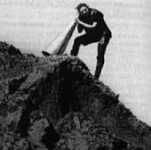 |
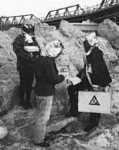 |
1989? - A Yard of Jungle - by Mark Dion - retraces the footsteps of William Beebe (1877-1962), an American naturalist/explorer who, through his skillful descriptive writing and zoological expertise, both revolutionized and popularized field biology and wildlife ecology. In 1917, while on one of the more than sixty scientific expeditions he undertook on behalf of the New York Zoological Society, Beebe dug up a square meter of earth in Belem, Brazil. He spent the steamship voyage back to New York City examining and classifying its contents. Mark Dion's reenactment of this project dramatizes the greedy obsession of nineteenth naturalists, who competed to collect and classify "unknown" species and be credited with their "discovery".
1989 - Since 1983 Stéphan Barron created several performances using telefax and radio across the Atlantic. In a performance called Lines in September 1989, he drove with Sylvia Hansmann along the Greenwich Meridian from Villers-sur-Mer on the English Channel to Castellon de la Plana in Spain. With a car fax they regularly sent images and texts relating to their trip to eight locations in Europe. This use of instantaneous communication technologies introduced a new way of representing a line, one of the most basic of human symbols. The faxes were projections of the Meridian which were 'fractalized', that is, the fragment of the line that was transmitted represented the whole. By experiencing their own meridian in this way, participants could think of themselves as 'measuring' it. http://www.technoromanticism.com/
1990? - Shanghai artist Shi Yong performed "City Space: Moving - Leaping 12 Hours". In this 12-hour action he becomes a city flaneur and he is open to all spontaneous changes and incidental discoveries. He walks on the street and receives regularly telephone instructions from other people at public telephone booths in order to know where to go next. The result is that within 12 hours he has traced a completely disorientated itinerary. At each point along the route, he has to redefine his own position and plan. - http://www.shanghart.com/text2.htm
1990? - For the project "The Reasonable Relation" Geng Jianyi, living in Hangzhou, pretended that he was mentally incapable to go out for a trip to Shanghai, but still wanted to catch the latest developments in the metropolis. Therefore, he hired another person to make the trip in his place. He settled a contract with this person promising to take charge of her trip to Shanghai to observe the city's changes. The employee was supposed to prove that she had actually realised the trip with as many as possible details, such as train tickets, hotel invoice, photographs and so on. - http://www.shanghart.com/text2.htm
1991 - Expedition to the centre of the earth. The Berlin artist-duo "p.t.t. red" travelled to the Stromboli volcano. There they positioned and released a 40 cm large lead plumb bob over the crater. It penetrated into the crater and started its imaginary journey towards the centre of the earth. Later in July 1994 they travelled to the ice volcano Snaefellsjoekull in Iceland. Buried in the glacier the second lead plumb bob pushes forward for the centre of the earth inside the glacier. It is accompanied by a selection of three- and plant seeds native to the Stromboli region. - http://www.bewer.de/kvn/programs/pttred2000.html
1992 - One week after the opening of Berlin wall it's disappearance was already foreseeable. Therefore on 17 November 1989 Rotraut Pape walked it's entire length with a camera. The walk starts in the Köpenicker Straße in Kreuzberg, and follows the painted wall, that followed different road courses. All crossing side roads had become dead ends in 1961. A few months later the artist walked this route again, with the camera firmly on the wall and toward that what had been hidden for so long. Then again in the summer and a fourth time in November 1990, exactly one year later. With it's four eyes the camera follows the wall through time; documents its disappearing and also reveals the hopefully positive horizons emerging on both sides. (DIE MAUER - DER NEGATIVE HORIZONT) - http://www.werkleitz.de/~pape/d/04projects/1992mauer/mauer.html
1993 - Gertrude Moser-Wagner took a trip to the italian village of "Indicatore". The village was chosen only for it's name. She took with her a series of tasks that her friends drew up for her. It was not easy to accomplish them in a non-touristic, rural village with somewhat suspicious inhabitants. Examples of tasks were:
| 1994 ?- Matt Frondorf drove across America in a
straight line from coast to coast and took pictures along
every mile of the trip. Matt began his roadside tableau
in New York City, where he framed the Statue of Liberty
and shot his first photo. Then he headed west to San
Francisco on as straight a line as possible, a camera at
his side clicking away at precise one-mile increments,
for 3,304 miles. When the camera clicked, it captured
whatever happened to be on that particular American
roadside. Matt calls his mile marker project
"statistical photography." - "A lot of
photography tends to be anecdotal and heavily edited, he
says. And it doesn't present what is really there, every
picture from beginning to end." http://www.kodak.com/US/en/corp/features/onTheRoad/interview/index.shtml
|
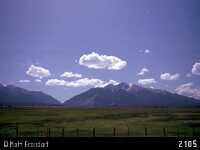 |
1994 - Alexis Rockman made an expedition through the jungles of Guyana for the purpose of observing the area's indigenous species. In the sewers of Georgetown, he found both human waste (sewage, oil, and chemicals) and living creatures (insects, frogs, and birds) that became both his subjects and his painting material. Rockman completed more than 200 mud-drawings in his New York studio, where he mixed the transported sewage (scooped directly from the ditch) with polymer, and painted with the end of a rough brush on watercolor block paper. http://hotwired.lycos.com/gallery/96/31/profile.html - http://hotwired.lycos.com/gallery/96/31/index4a.html
1994 > Christoph Draeger made a series of photographs (Voyages Apocaliptiques) showing unpretentious landscapes and urban panoramas. It is not immediately evident why these ordinary places should be special. Nor do the titles give a clue. Background knowledge is necessary to understand the tragedies that have taken place here:
1995 - Lars Wallsten photographs scenes of crimes after the police has left. He concentrates on uneasy details like wounds, blood-stains, footsteps and broken windows. (Images of Crime)
1996 - Photographers Theo Baart
and Cary Markerink and journalist Tracy Metz studied the
Dutch highways and made the book Highways in the
Netherlands.
|
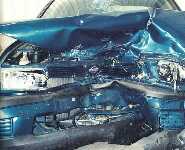 |
| 1996 > Every week Battista Ilic, Ivana Keser and Tomislav Gotovac set out on Sunday trips on Medvednica hill, on the outskirts of Zagreb. These outings and all the activities and happenings connected with them have been recorded with the camera using the self-timer. Over 800 slides have been produced so far and presented as part of the project in the galleries, museums, and distributed as postcards by mail to numerous friends and institutions. The project was shown on the web, and it was presented through jumbo posters stuck on billboards all over the town of Bregenz. (Hallelujah the Hill) | 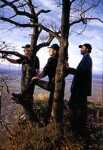 |
1996 - Joel Sternfeld published a book showing public spaces, parks, shops, woodlands, schools, restaurants and factories. The photographs look very ordinary and unspectacular until the accompanying text is read. Then it becomes apparent that all of these places are in fact scenes of violent crime.
| 1996 - The Belgian-Mexican artist Francis Alys started a series of works in 1993 in which walking was the central theme. In NARCOTOURISM (Copenhagen, Denmark 6-12 May 1996), Alys underlined the transcendent quality of these ambulant projects, in which physical presence is linked to mental absence. Over the course of seven days, the artist made a series of walks under the influence of different drugs: alcohol, hashish, speed, heroin, cocaine, valium and XTC. The effect of each drug lasted fourteen hours. | "I will walk in the city over the course of seven days, under the influence of a different drug each day. My trip will be recorded through photographs, notes, or any other media that become relevant." |
1996 - In February and March of 1996 Mark
Dion and Stephan Dillemuth hired a van and explored the
coast of the North Sea and the Ostsee. They collected
objects that they found on the shore and exhibited them
like a scientific collection:
|
They constructed a special two-sided chest to display
the findings from the two seas. The expedition was
further documented in photo-albums, postcard-collections
and films. The work evoked the atmosphere of 19th century
expeditions and collections of mad scientists. (A
tale of two seas)
|
1996 - Sophie Calle researched how the inhabitants of (former) East Berlin remember the socialist monuments that have been removed since the fall of the communist regime (Die Entfernung).
1997 - German Artist Gerhard Lang (Land?) constructed a wooden box containing a glass vial with a valve. He walked into the hills until he found a cloud covered hilltop. There he took a sample of the cloud and brought it home with him. The weight of the box and vial (without cloud) was 6.5 kg. The artist made a photo-documentation of this walk.(Cloud Walk 5)
| 1997 - Inspired by the American road movie Paul Ramirez Jonas made the 20 minute video A Longer Day. He left his studio at sunrise and, his video camera pointing directly out of the windscreen, drove due west until sunset. It is at this point that we join the video, the sun flaring in the camera lens in a way reminiscent of Easy Rider. Travelling at speed, in the same direction as the sun, Ramirez Jonas is able to delay its disappearance; at times it sets beneath the inclined road only to reappear, moments later. The fundamental rhythm of daily life - that of the sun rising, then setting - is disrupted by the simplest of highway journeys. In its desperate attempt to extend the optimism of the American Dream, it is a work of immense romanticism. | 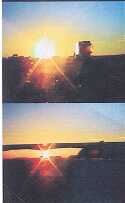 |
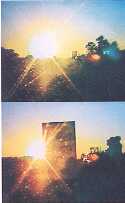 |
1998 - Eglé Rakusaité (Lithuania) made video-stills of street musicians in Vilnius, London, Lisbon and New York (Street Musicians).
| 1998 > Peter Rösel regularly visits Namibia to
paint mirages. He takes his easel and painting into the
desert and then waits for suitable atmospheric
conditions. (Fata Morgana Projekt) In another project the artists looks for people who have seen elves, dwarfs, kobolds, trolls etc. and then he paints these mythical creatures as they are described to him. (Phantomzeichnungen) |
 |
1998 - Stefan Kaegi writes: For Winterhilfe 98/99 I joined San Keller for fifteen hours on one of his six nightwalks through the Alps: 45 kilometers over 1200 metres of difference in height. Countless blisters on both of my feet, I pronounced curse after curse into the Italian night. Next to me San Keller smiled as if he wanted to validate Buddhism. He was like one of those watch dogs that provide victims of avalanches with spirits while wagging their tails. - http://www.uni-giessen.de/diskurs/diskurs_99_-_groups___san_kell.html
1999 - Boris Michailov (Russia) portrays the lost souls of Charkov, run aground after the fall of the Soviet Union. Homeless people, drunks, prostitutes and glue-sniffing children are paid by the artist to pose for his dramatic and shocking photographs. Often they are portrayed naked so that their ragged bodies with wounds and skin-diseases are clearly visible. They pose in drab apartments, derelict courtyards and neglected urban woodlands. The artist has close ties with the people he portrays, for example they can come to his own apartment to take a bath. (Case history)
199? > Rikrit Tiravanija once arranged furniture in an exhibition space, set up a temporary kitchen, cooked curry, and chatted with visitors while the gallery’s everyday business carried on all around him. In the Cologne Kunstverein Gallery, he created a makeshift rendition of his New York apartment, including a kitchen and bathroom, and simply invited people to set up camp. Equipped with camping gear and a portable stove, he rode his bike for five days across Spain and attracted crowds of people to visit and converse with him.
2000 - The Dutch artist ? Van Loon travelled from Copenhagen to Helsinki, Berlin, Vienna, Rome and Athens and almost every capital of Europe. In every city he invited the inhabitants to make paintings on his car. In fact his car has become a driving gallery. He hopes to finish his trip with 1000 paintings attached to his car.
2000 - Heike Jechonnek has collected - and exhibited - water from 30 European rivers (Union of the flowing Eutopie).
2000 - Hermann Prignann and Eijo Okubo started their separate expeditions from Portugal and Japan. They met in the middle, on the holy mountain of Kailas in Tibet. Here they erected a monument. The documentation of the expedition is presented in the art gallery.
2000 ? - Bernardo Giorgi travelled along the Polish-German border and researched the thoughts of the inhabitants on one side about the people on the other side. He also made a psychological map of the area. (German - polish frontier changes after the maximum of the last glaciation)
2000 - Haim Steinbach collects the "ordinary" objects he finds in random people's private homes and he puts them in the museum. These non-artistic objects (glass vases, a folded paper hat, porcelain cups, teapots, bowls, shells etc.) are displayed together with a video-presentation of their normal surroundings (the house of the owner) and the story of their owner (what makes this object so special). The artist calls himself a "collector of collections" and considers his art as a "field research" into the "psychology of things". An object is not seen as a dead thing but as a focus for memories and emotions. (North, East, South, West - Berlin)
| 2001 - Miguel Palma travelled the distance between the cities of Rotterdam (Netherlands) and Porto (Portugal), the joint Cultural Capitals of Europe. He hung a trailer behind his car with a model of an imaginary city in a plastic case. The city would gradually collapse due to the shakes and bumps of the trip, as if being struck by a series of miniature earthquakes. The trailer also contained the white, alien-like inhabitants of the city and a basin with water, creating miniature tsunami's all the time. However, quite unexpectedly, the city and its inhabitants survived the trip unscathed. The container was displayed in the gallery together with a video-report of the journey showing "giant" waves flooding the miniature city-square. | 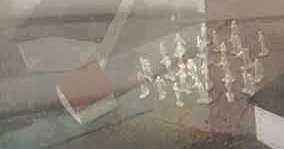 |
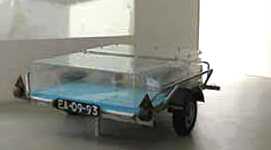 |
| 2001 - Bozidar Brazda flew a seven foot reproduction
of Van Eyck's Man In A Red Turban to Bangkok (from
Toronto) and carried it around the go-go bars (houses of
questionable repute) until he found a girl that was
willing to draw all over it. The note with the instructions that the artist had prepared beforehand was incorrectly translated and so it took a good forty-five minutes of hand gestures until the lady realised that the artist didn't want to paint her nude portrait. At the moment the artist still hasn't translated the text she scribbled over the entire canvas. |
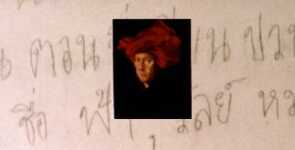 |
2001 - Many works by
Francis Alÿs are destined for other places than the
exhibition place. For example, the many hikes that the
artist has made. A collection of postcards with a picture
of the rambling artist and a short description of the
activity are the only tangible proof for these actions:
|
 |
|
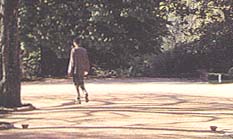 |
2001 - San Keller organised several art happenings with the cunning name "winter assistance". On certain winter weekends one could take a ride in a bus with a full tank, together with the artist. The group then started toward a selected European metropolis. - The drive continues until the last drop of gasoline is used up and until the bus stops. Then the happening begins. Together with San Keller the group walks towards the next gas station, in order to fill the portable fuel-cans with gasoline, so that the group can drive home again. One action is guaranteed to take at least 24 hours. The whole trip costs 50 Swiss Francs including food and beverages. - http://www.wahnsinnzz.com/trendfax/zuerich/12.2001/texte/film.html
| 2002 - San Keller shares 1000 Swiss Franks with you! - Saturday, 16 March 2002, at 10.00 o'clock San Keller left the centre of Zurich with 20.000 5-rappen (5 cent) coins in his backpack. He was followed by a small crowd of supporters. They knew: as soon as San Keller would break down under his load, they could help relieve his burden. Each one would get a share of the heavy coins and together they would return to the city. This final moment arrived after 3 1/2 hours at the Felsenegg-hill outside of the city. (San Keller teilt sFr. 1000.- mit Ihnen) |  |
 |
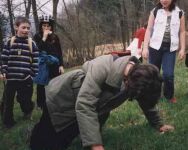 |
Back to: Urban Adventure in Rotterdam
© 1999 Petr Kazil - 28 January 2000